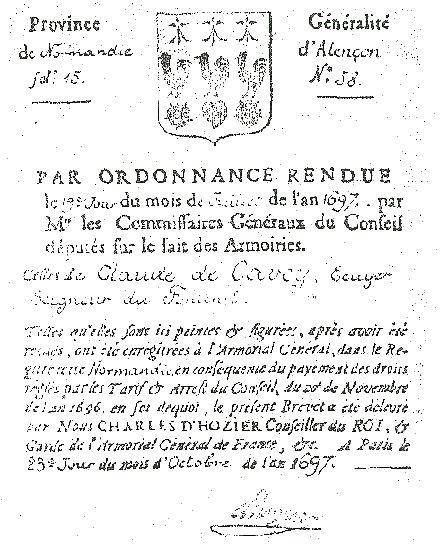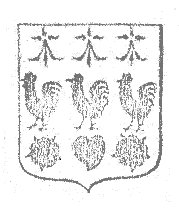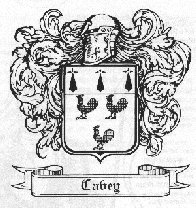Arms of Claude (de) Cavey |
116,914 people, of whom 80,000 were not nobles, 2,171 villages, 934 towns and 28 generalities (i.e. administrations encompassing several provinces) were registered. The arms and titles are preserved in the "Bibliothèque Nationale de France François Mitterrand", Paris, in 70 handwritten folios. 35 are descriptions of the arms and 35 show a colour drawing of the arms.
The deed of registration of the coat of arms of Claude Cavey (also known as Claude de Cavey) is shown below. It is dated 19 July 1697.

The text is in Old French (note that the letter 's', when not at the end of a word, looks like the letter 'f') and can be transcribed roughly as follows:
![]() Left top corner : Province of Normandy, Folio N° 15
Left top corner : Province of Normandy, Folio N° 15
![]() Right top corner : Generality of Alençon , N° 58
Right top corner : Generality of Alençon , N° 58
![]() In the middle : the drawing of the coat of arms of Claude (de) Cavey. The document I have in my possession is a photocopy, and is therefore in black and white, but we have their description.
In the middle : the drawing of the coat of arms of Claude (de) Cavey. The document I have in my possession is a photocopy, and is therefore in black and white, but we have their description.
![]() The text below the arms can be transcribed as follows (word for word):
The text below the arms can be transcribed as follows (word for word):
"By order of the 19th day of July 1697, by the General Commissioners of the Council deputised on the subject of coats of arms. Those of Claude de Cavey, Esquire Lord of Fontenil, as they are here painted and figured, after having been received, have been registered in the General Armorial in the register of Normandy, as a consequence of the payment of the rights regulated by the tariffs and decrees of the Council of November 20, 1696. In witness whereof, the present patent has been delivered by us, CHARLES D'HOZIER, King's Councillor, and guardian of the General Armorial of France. In Paris, on the 23rd day of the month of October of the year 1697. Signed D'HOZIER".
![]() As written in Caveys in France, the arms of Claude de Cavey were registered in the "General Armorial of France" on 19 July 1697. They are described as follows (in old French and in heraldic vocabulary, untranslatable into English):
As written in Caveys in France, the arms of Claude de Cavey were registered in the "General Armorial of France" on 19 July 1697. They are described as follows (in old French and in heraldic vocabulary, untranslatable into English):
"Argent, three ermine spots in chief, three roosters in front and a heart between two roses in base."
Chris Cavey has found a Cavey coat of arms. Unfortunately, we have no information about them. It may be that they are the ones described in the Rietstap and Rolland versions of the General Armorial.
| Arms of Claude de Cavey | Cavey's coat of arms | ||
| The background is silver. |  |
 |
The background is silver. |
| On the chief: three ermines. | On the chief: three ermines. | ||
| From the front three red roosters. | From the front three red roosters in a triangle. | ||
| In point a red heart surrounded by two red roses | No heart or rose tips. | ||
Source : Bibliothèque de France |
October 23, 1697 | No date (after 1861) | Source : Bibliothèque de France |
The two red roses in Claude de Cavey's version are intriguing to professional coat of arms designers as it is usually accepted that they are related to the Tudors 'Family who were rulers of Scotland (remembers "the War of the Two Roses" , 1460-1485 , in England).
So? We can assume that the armories found by Chris Cavey are those described in the three volumes of V. & H. V. Rolland's "Illustrations de l'Armorial General par J. -B. Rietstap" (see Ronald D. Cavey on the debate page), they were first published in Paris, France, in 1861 i.e. two hundred years after those described by d'Hozier. The coat of arms is described as follows: "Cavey - Normandy. Argent, three roosters Sable crested, beaked, barbed and membered Gules; on a chief of the first, three ermine spots on the second."
Nevertheless, the Rolland-Reistap books are not official publications, whereas d'Hozier's Armorial was made by order of Louis XIV.
In any case, bear in mind that :
- Having a coat of arms is not necessarily a criterion of nobility. As mentioned above, 80,000 non-nobles registered their arms in 1696 / 1697.
- Having a particle is not a sign of nobility either. Claude de Cavey was also known as Claude-Philippe Cavey (see : Caveys in Belgium & India and Caveys in France)
- But to have the title of escuiller-seigneur, proves without any doubt, a noble origin since time immemorial (that is to say that the noble character was recognized from all times and that it is not necessary to bring the proof). This is confirmed by the fact that the name comes from Latin which shows a very old name that is rare in France (most family names appeared in the 14th century).
More about Heraldy :
Grand-Armorial.Net. This site has a very useful glossary in both French and English.
Cavey: Argent, three roosters sable, crested, beaked, barbed and membered Gules, on a chief Argent, three ermine spots Sable ® (Rietstap)
Cavey du Fontenil: Argent, three ermine spots sable, in chief three roosters in fess and a heart between two roses in base Gules
Note, it is not known whether the roosters are accosted or fesswise ordered.
Heraldica (English)